A Hospital to Serve an Entire Region: The Hôtel-Dieu de Gaspé
When it’s time to travel, some people decide to explore Quebec and the wonderful scenery of its different regions. You don’t need to travel far for an adventure, whether it’s with your significant other, friends, or entire family. Gaspésie is always a popular destination because of its various tourist attractions, enchanting views, and beautiful nature, which is perfect for outdoor activities.
However, the area hasn’t always been so easily accessible. It has only been possible to go around the Gaspé peninsula since 1929, the year when route 6 (today’s route 132) was completed[1]. There were many roads that connected the different villages between them, but if you left Québec by car, the road only went as far as Matane in 1925. The only other possibilities were a railway that was still lacking, or maritime transportation. The St. Lawrence River was still the simplest way to get to Gaspé.
That’s what two Augustinian Sisters from the Hôtel-Dieu de Québec did when they embarked on the S.S. Northland on September 23, 1926, to establish the Hôtel-Dieu de Gaspé. Their goal: offer hospital care to the inhabitants of the Gaspé peninsula, which was then greatly lacking in this respect[2]. There was a small hospital in Chandler, founded in 1915, but it couldn’t meet the demands of such a vast territory, on top of having limited accessibility[3].
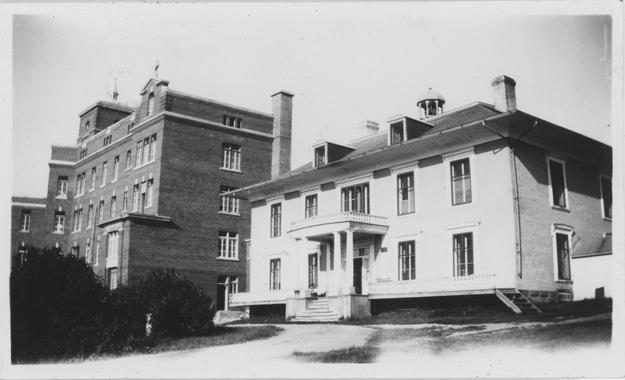
Fonds du Monastère des Augustines de l’Hôtel-Dieu de Gaspé
(HDG-G1-M1,3/2:22)
© Archives du Monastère des Augustines
Mgr François-Xavier Ross: a bishop serving Gaspésie
The Gaspé bishop, Mgr François-Xavier Ross, was the one who fought for the establishment of a hospital in Gaspé. His wish was for Gaspé to become a true episcopal city. Although the sisters of Notre-Dame du Saint-Rosaire had already held a school there since 1917, Mgr Ross also brought the Ursuline Sisters over to first open a teacher-training school, before managing a boarding school, as well as a domestic science school. In 1926, the small seminary was completed, and entrusted to the Jesuites[4]. The same year, Mgr Ross invited the Hôtel-Dieu de Québec’s Augustinian Sisters to manage a hospital in Gaspé. It is said that Mgr Ross wished to recreate the founding of Québec by emphasizing the rapid establishment of the Jesuites, Ursulines, and Augustinians in the Gaspé peninsula[5].

Fonds du Monastère des Augustines de l’Hôtel-Dieu de Gaspé
(HDG-G1-M1,1/4:4)
© Archives du Monastère des Augustines
Finally, a hospital in Gaspé!
Negotiations had been started with the Hôtel-Dieu de Québec Augustinian Sisters; the superior from the Hôtel-Dieu de Québec and her steward even made the journey to the location in August of 1926 to get a better sense of the magnitude of the task at hand[7]. On August 19, 1926, the Gaspé bishop submitted an official request for them to accept the mission of founding the Hôtel-Dieu de Gaspé, which would be under the patronage of Notre-Dame-des-Neiges[8]. For him, “this institution will be developed by being completed with other works of mercy, providing your constitutions allow it and that Providence makes it possible for us.”[9] The Augustinian Sisters even suggested erecting a new building, but the summer was already nearing its end. Therefore, they resolved to convert the Fort Ramsay house into a hospital on the lower level, and an adequate cloister on the upper level while awaiting a new building in the spring[10].
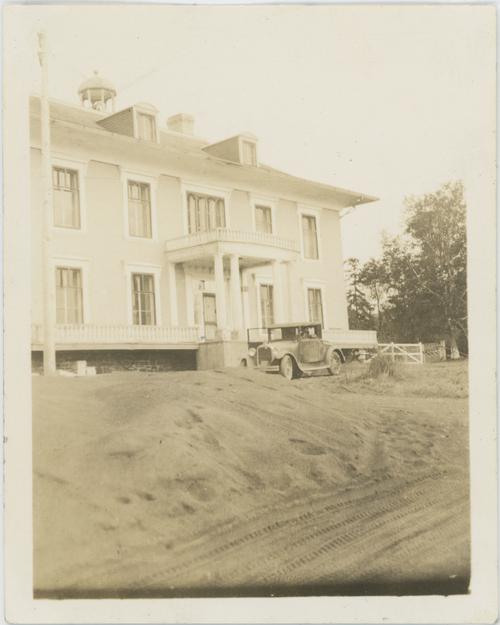
Fonds du Monastère des Augustines de l’Hôtel-Dieu de Gaspé
(HDG-G1-M1,3/2:13)
© Archives du Monastère des Augustines
A difficult first few months
On September 15, 1926, Sister Marie-de-l’Incarnation (Marie-Louise Cantin) was elected first superior and founder of the Hôtel-Dieu de Gaspé. Sister Marie-de-l’Incarnation was conscious of the pressing needs in Gaspésie: “Now we will have a hospital for our dear patients, who until now were forced to make difficult journeys to hospitals located two hundred, five hundred, or seven hundred miles away, or resolving to await death patiently in their families, without the care that could have saved them[11].
Sister Saint-Albert (Amarilda Gagnon) was chosen as her assistant. The two nuns boarded the boat to Gaspé on September 23, where they were welcomed by the Ursulines two days later. They were lodged in the Ursulines’ monastery until November.
The Augustinian Sisters had to set up their monastery-hospital to be able to welcome their sisters, as well as their first patients. To oversee the work, they crossed the bay daily, using a small rowboat. If the waters weren’t favourable, they had no choice but to go “to a very impractical and primitive landing stage, which isn’t very pleasant. The men on board had to lift them up in their arms for them to be able to put their feet on the dock, which was half-broken.” [12]
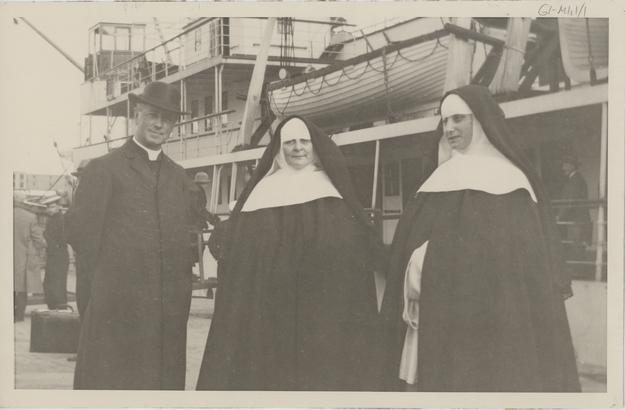
Fonds du Monastère des Augustines de l’Hôtel-Dieu de Gaspé
(HDG-G1-M1,1/1:1)
© Archives du Monastère des Augustines
They were finally joined by four other Augustinian Sisters from the Hôtel-Dieu de Québec, who left their monastery on October 27, 1926: Sister Saint-Norbert (Josephte Belleau), Sister Sainte-Marguerite (Marie Félonise St-Pierre), Sister Saint-Michel (Edith Chénard), and Sister Marie-de-l’Assomption (Blandine Bourret). Unlike the first two, the group chose to travel to Gaspé by train, joined by Mgr Ross, who had also boarded the boat a few months prior to travel with the two founders[13].
The Augustinian Sisters moved into their new monastery on November 25, 1926, after a few weeks of cohabitation with the Ursulines. The work was complete, but they weren’t out of the woods yet, experiencing problems with water supply and electricity, among others[14].
Despite all the problems, they welcomed their first patient on January 3, 1927, and the first surgery took place two days later. The hospital was equipped with an X-ray machine, sterilizer, operation table and laboratories. After one year in operation, the hospital had already treated 525 patients. However, the hospital was quite small and only had 20 beds. Shortly after arriving in Gaspésie, it was already time to upgrade. In 1930, a new location was inaugurated, allowing them to increase the hospital capacity to 75 beds. The Fort Ramsay house would now serve exclusively as a monastery for the Augustinian Sisters[15].
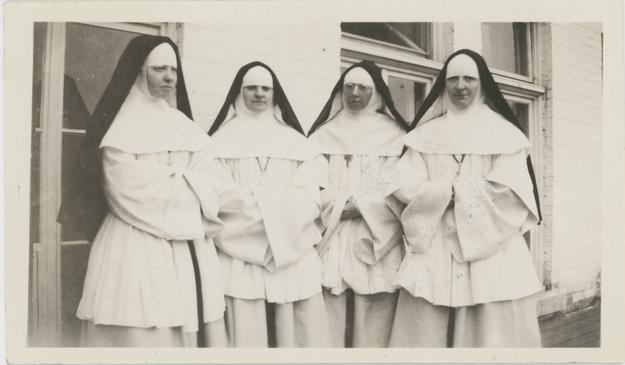
Fonds du Monastère des Augustines de l’Hôtel-Dieu de Gaspé
(HDG-G1-M1,1/4:17)
© Archives du Monastère des Augustines
Another expansion and a sanatorium
A little over 10 years after the construction of the hospital in 1930, there was another need for expansion. The demand was blatant, particularly after years of economic crisis. In 1939, the Gaspé-Sud county counted 250 patients suffering from tuberculosis, and the Hôtel-Dieu de Gaspé could only dedicate 25 beds to them. The Ministère de la Santé granted $50,000 in September 1939 toward the construction of a new wing which would hold 75 beds, 50 of which would be dedicated to tuberculosis patients. At the same time, a pediatrics and maternity service were to be added[16].
Even with an additional wing, treating tuberculosis required additional investments. Before its construction, Mgr Ross had already announced his intention to establish a sanatorium in Gaspé to the provincial government, the goal being to focus even more on treating tuberculosis. World War II delayed the project by several years, but in July 1945, the Gaspé bishop obtained approval from provincial authorities to build the sanatorium, shortly before his death. It finally opened its doors in 1950, under the name of Sanatorium Ross. Perched atop Mont Albert, it could welcome 400 patients from all around Gaspésie and the Îles de la Madeleine. There, too, the Augustinian Sisters devoted themselves body and soul to caring for the sick, helped by the St-Augustine Hospitallers, and then the Sisters of Saint Anne[17].
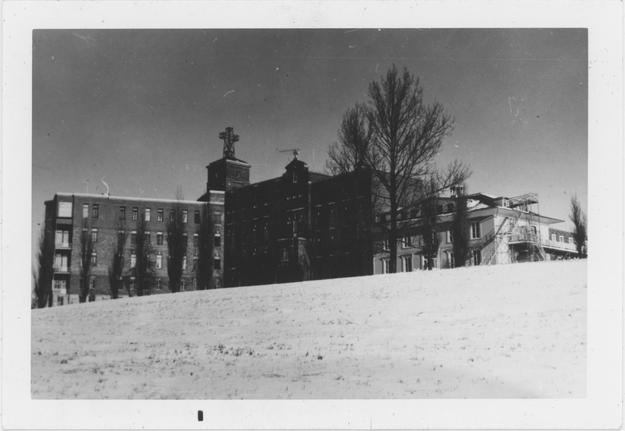
Fonds du Monastère des Augustines de l’Hôtel-Dieu de Gaspé
(HDG-G1-M1,3/2:203)
© Archives du Monastère des Augustines
Another move
In 1964, the monastery had become nearly uninhabitable for around 40 nuns. This is what brought on the plans to build their new home, which welcomed them in 1966[18].
Around the same time, the Augustinian Sisters had to give up the management of their hospital due to the adoption of the Hospitals Act in 1962, which “made way for the creation of corporations independent from religious communities for the management of hospitals” [19] In 1964, the Hôtel-Dieu de Gaspé became a true medical centre devoted to caring for the entire Gaspésie population[20].
A nursing school was also built alongside the monastery, and opened its doors in 1968. The school was quickly integrated with the Cégep de la Gaspésie, also established in 1968.
Construction of the current hospital began on August 5, 1969. It officially opened its doors on November 22, 1972, under the name Centre Hospitalier de Gaspé. Today, it admits over 15,000 people every year through its emergency room. The Sanatorium Ross now houses a ministerial call centre, a CHSLD, and for another few years, the hospital’s psychiatry department[21].
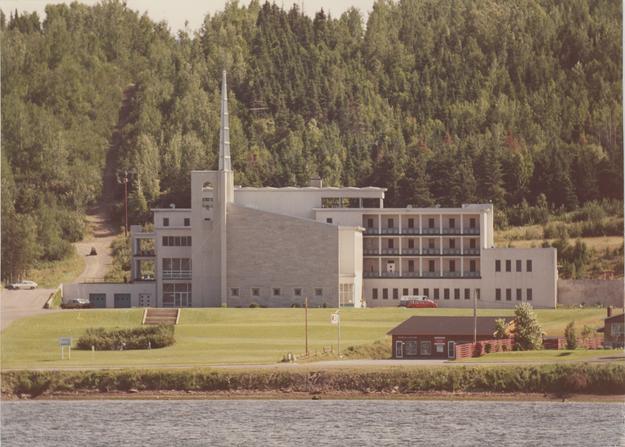
Fonds du Monastère des Augustines de l’Hôtel-Dieu de Gaspé
(HDG-G1-M1,5/2:20)
© Archives du Monastère des Augustines
A pioneering heritage
Although the buildings that housed the first monastery and hospital no longer exist today, their mark is still quite present. The second monastery was reconverted into a nursing home in 1995, called Manoir St-Augustin. Also, a good portion of the land was sold, and is now part of the Parc Industriel des Augustines, where several industrial and para-industrial companies have settled[22].
Beyond inspiring the names of places
that still exist today, the Gaspé Augustinian Sisters were the pioneers of
health care in the Gaspésie area. A deep sense of duty was necessary to embark
on such a big adventure. The sisters left their monastery in Québec and traveled
hundreds of kilometers to ensure their new home was inhabitable, on top of
making it adequate to care for the sick. Still today, access to health care is
an important issue in areas far from urban centres, but it is clear that the
Augustinian Sisters played a pioneering role in Gaspésie.
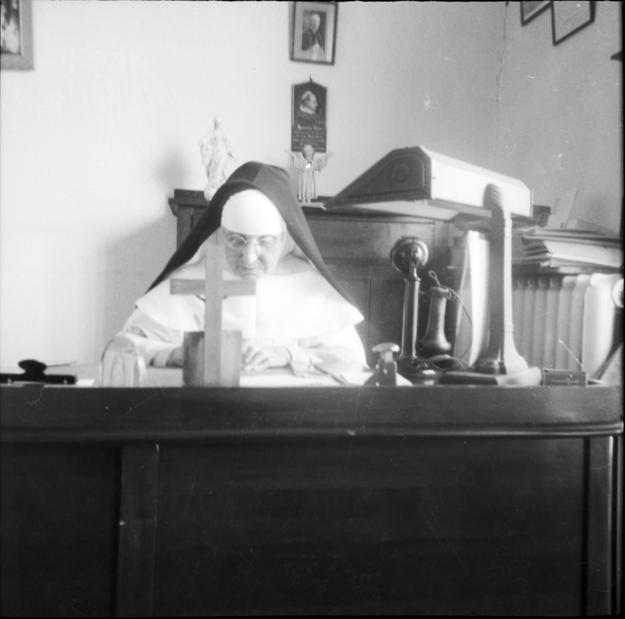
Fonds du Monastère des Augustines de l’Hôtel-Dieu de Gaspé
(HDG-G1-M1,1/2:4)
© Archives du Monastère des Augustines
[2] Mgr François-Xavier Ross “Les Religieuses Hospitalières de la Miséricorde de Jésus à Gaspé”, letter from 1927, published in Revue d’histoire et de traditions populaires de la Gaspésie : Les 50 ans de l’Hôtel-Dieu de Gaspé, April-June-July-September 1976, no 54-55, p. 72.
[3] Mgr François-Xavier Ross “Les Religieuses Hospitalières de la Miséricorde de Jésus à Gaspé”, letter from 1927, published in Revue d’histoire et de traditions populaires de la Gaspésie : Les 50 ans de l’Hôtel-Dieu de Gaspé, April-June-July-September 1976, no 54-55, p. 72.
[4] Ibid., p. 561.
[5] Mgr François-Xavier Ross, op. cit., p. 74.
[6] Ibid., p. 72.
[7] Mgr Paul Joncas, “Mgr F.-X. Ross, le premier fondateur de l’Hôtel-Dieu”, Revue d’histoire…, op. cit., p. 81.
[8] Laurette Arsenault, “Les fondatrices”, Revue d’histoire…, op. cit., p. 90-92.
[9] Mgr François-Xavier Ross, letter from August 19, 1926, quoted in Mgr Paul Joncas, op. cit., p. 81-82.
[10] Mgr Paul Joncas, op. cit., p. 82.
[11] Exerpt from a mandate by Mgr F.-X. Ross, erecting the Augustinian Sisters’ monastery in Gaspé (No 320)
December 8, 1926, p. 349-350, quoted in Laurette Arsenault, op. cit., p. 91.
[12] Félonise St-Pierre, Petites notes sur les premiers temps de notre fondation, Revue d’histoire…, op. cit., p. 98.
[13] Ibid., p. 99.
[14] Mgr Paul Joncas, op. cit., p. 84.
[15] Marc Desjardins et al., op. cit., p. 588.
[16] Ibid., p. 588.
[17] Angèle Bélanger, “Les Augustines et le soin des tuberculeux”, Revue d’histoire…, p. 193.
[18] Odilon Cotton, 50 ans de service médico-chirurgical, Revue d’histoire…, p. 164.
[19] Vincent Lemieux, Le système de santé au Québec : organisations, acteurs et enjeux, Québec, Presses de l’Université Laval, 2003, p. 16.
[20] Yvonne Richard, “L’administration religieuse : 50 ans de vie hospitalière pour les Augustines de la Miséricorde de Jésus”, Revue d’histoire…, p. 143.
[21] “Une unité de santé mentale à l’Hôpital de Gaspé”, Radio-Canada, [online: https://ici.radio-canada.ca/nouvelle/1220388/psychiatrie-soins-sante-mentale-gaspesie], Accessed August 9, 2019.
[22] Urban masterplan No 1155-11, Ville de Gaspé, 2011.

